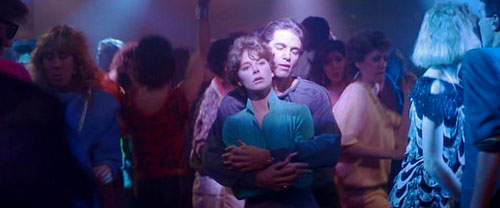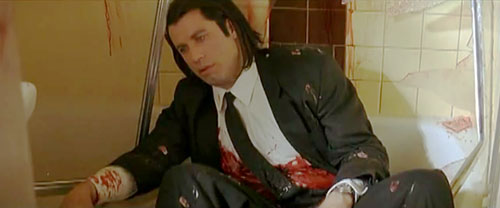Three Theses on Fright Night
•THESIS #3: John Travolta must die.
There are three bits of evidence we need to line up. First, the vampire in Fright Night is played by Chris Sarandon, given name Sarondonethes, which means he’s Greek, the darker side of white, not easily confused with Robert Redford or Owen Wilson. Second, the vampire ensnares the hero’s young girlfriend on the main floor of a throbbing disco, wading into the crowd to dance his gorgon’s boogaloo. Third, he is almost always wearing a man’s dress scarf, which generically marks him out as a swell and specifically, in 1985, seemed to insinuate the ultra-wide collars that had just gone out of style: an amplitude of color spreading out from the neck.
More precisely, it was the combination of scarf and popped collar that approximated the polyester wingspan of a few years back. And approximation is very much the point, since Chris Sarandon was plainly cast in Fright Night because he made a passable surrogate for John Travolta. One of the names for the demon-seducer who engrosses to himself all the women is “father,” but his other is “Tony Manero.” And you can, if you like, think of this figure—the Travolta vampire-dad—in terms of a precise historical moment: The entire movie takes shape in the headspace of a child of the late ‘70s and early ‘80s, someone who has grown up under the strains of “You Should Be Dancing” and “If I Can’t Have You” and who has therefore latched onto Vinnie Barbarino and Danny Zuko as the standard of the masculinity that he will never meet. All of Fright Night is premised on a bowel-shaking fear of John Travolta, the dreadful realization that no American man will ever have sex again until Travolta is destroyed. The struggle that Fright Night stages is in this sense something more than Oedipal; it isn’t just a conflict between an under-ripe masculinity and a fully adult one, since its junk Freudianism has been given such an obvious ethnic overlay: a whitebread masculinity squares off against sheerest Ionian potency. The movie’s adolescent fear of older men is intensified by a worry that a preppy, suburban kid—a 15-year old in a tweed jacket!?—is never going to be able to compete with Travolta’s goombah swank. And this obviously brings us back to Valentino and the Lugosi Dracula. Something we said earlier we’ll want to repeat now as a general point: Not just that Lugosi tapped into a fear of Valentino, but that vampire movies as a genre periodically inculcate a fear of Italian actors. And with this in mind, we can return to the clip from Ken Russell’s Valentino and gawp again at its unlikeliness: Nureyev is playing Valentino as Dracula, but Travolta is the scene’s third term, or, if you like, he is proximate double to its devil-sheikh. Lugosi gives us Dracula + Valentino, and Chris Sarandon Dracula + Travolta, but only Nureyev delivers Dracula + Valentino + Travolta in one. The Russell biopic came out in October of 1977, Saturday Night Fever two months later. And Fright Night, at eight years remove, is Disco Demolition Night restaged as a vampire story: A Mediterranean fop dies so that his WASP neighbors will sleep better. A crate of records explodes on a baseball field.




One response to “Staying Alive, Part 2.3”